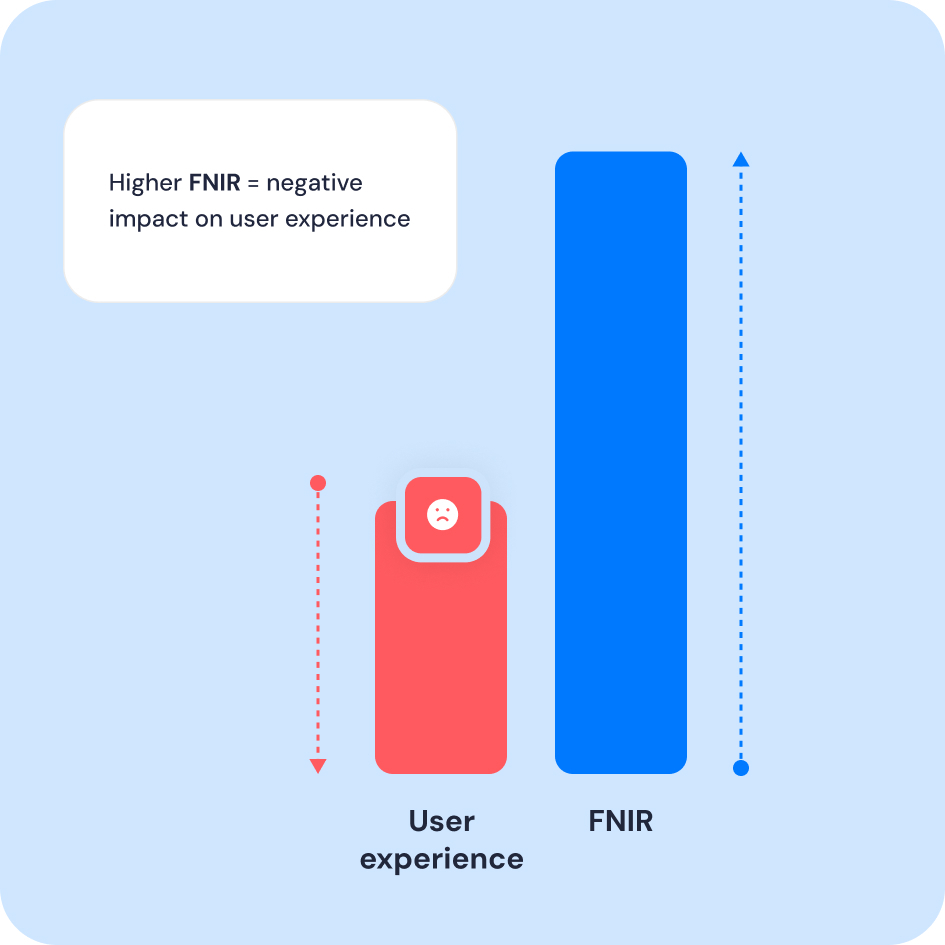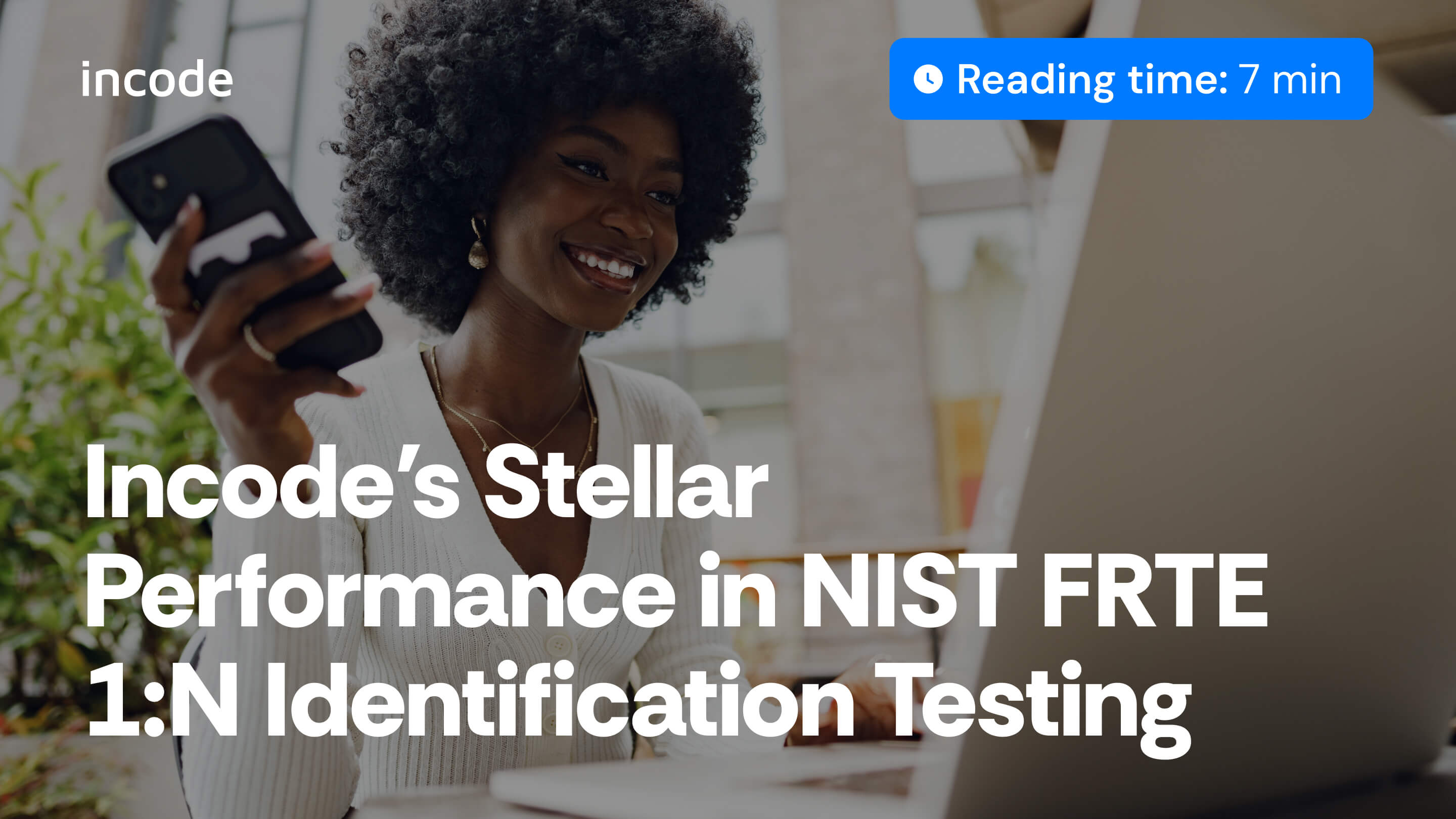Incode’s Stellar Performance in NIST FRTE 1:N Identification Testing: A Testament to Accuracy and Leadership in Facial Recognition

In recent years, facial recognition technology (FRT) has become an important tool for many online businesses seeking a relatively low-friction means of verifying or reverifying a person’s age or identity.
All a user needs to do is upload a selfie, and in seconds the technology does the rest — analyzing the image and comparing it against either a previously uploaded selfie, an ID photo, or a photo contained in an authoritative source, like a government database. The result is less friction during onboarding or reverification, higher conversions, and a more satisfied user base.
Sounds great, doesn’t it?
But facial recognition technology is only helpful if it’s accurate. If the model fails to recognize legitimate users or falls victim to spoofs, deepfakes, and other AI-generated assets designed to generate a false positive, then the value it offers businesses is dramatically reduced.
With this in mind, the National Institute of Standards and Technology (NIST) evaluates and ranks facial recognition technologies on accuracy and other metrics. NIST recently completed its 2024 evaluation, and Incode is proud to announce that our solution has ranked exceptionally well against competing models.
Below, we take a closer look at the metrics NIST tested, how Incode performed, and why accuracy is so important in facial recognition.
Understanding the Metrics: FNIR and FPIR
Before diving into the results of NIST’s recent report, we thought it would be helpful to offer a quick primer on the specific metrics that were being tested: FNIR and FPIR.

What is False Negative Identification Rate (FNIR)?
FNIR stands for False Negative Identification Rate. It’s a measure of how frequently a facial recognition technology might return a false negative when it evaluates a user’s identity; i.e., that it might incorrectly say that a legitimate user is not who they say they are. It’s also called False Negative Match Rate (FNMR).
A high FNIR has a negative impact on user experience because it means that legitimate users might be rejected from accessing an account, platform, or service that they should be able to access. With this in mind, the lower the FNIR, the less you will need to worry about legitimate users being incorrectly turned away.

What is False Positive Identification Rate (FPIR)?
FPIR stands for False Positive Identification Rate. FPIR measures how likely it is for a FRT to incorrectly identify one person as another; i.e., that it might incorrectly identify a fraudster or deepfake as a legitimate user.
A high FPIR has negative implications for security, because it means a fraudster may have an easier time getting around a facial recognition technology. The lower an FRT’s FPIR, the less you will need to worry that a fraudster will get through your security defenses.
FNIR vs. FPIR
With many facial recognition technologies, there is a tradeoff that must occur between FNIR and FPIR. That’s because both are dependent on how strict a FTE’s match requirements are.
When your match requirements are stricter, it can mean greater security — but it also means a legitimate user might occasionally be turned away. When the match requirements are more relaxed, it can mean a more accommodating user experience — but it also means that a fraudster may occasionally get through.
In evaluating a facial recognition solution, businesses need to consider their own goals and what matters more to them — user experience or security. In most cases, you should determine the highest FPIR that your business is willing to accept, and then select the FTE that meets that threshold while also providing the lowest FNIR. This is why choosing the right IDV partner is so important: There doesn’t need to be a tradeoff between user experience and security.
Incode’s Outstanding Results
As a part of its 2024 report, NIST evaluated a total of 158 different developers accounting for 527 unique algorithms between them. Each developer was tested against a number of galleries containing different types of images — Mugshot, Visa, and Border images — with a population size of n=1,600,000 and a threshold that limited the FPIR to 0.003.
With these testing parameters in place, Incode performed exceptionally well, ranking #1 out of all full solution IDV providers evaluated.
Incode performed equally well in the following datasets (out of all full-solution IDV providers):
- Visa-Border (Lowest FNIR)
- Mugshot-Webcam datasets (Lowest FNIR)
- Mugshot-Mugshot (2nd lowest FNIR)
- Visa-Kiosk dataset (Top 3 lowest FNIR)
- Mugshot-90 degree profile dataset (Top 3 lowest FNIR)
Moreover, Incode was ranked #1 out of all full-solution IDV providers: The highest-scoring IDV provider in this testing.

The Importance of Accuracy in Facial Recognition
Facial recognition technology can be an incredibly powerful means of verifying a user’s identity during account creation, log-in, or reverification — often, with significantly less friction than other verification methods allow. But it’s only a viable solution if it’s accurate. Significant inaccuracy in terms of both false negatives and false positives can introduce risks for businesses.
At first blush, false positives may appear to be the more serious concern out of the two. After all, a false positive means that a user was incorrectly identified as being a different person. In practice, this might mean that a fraudster has been given access to data (like PHI or PII) or an account (like a bank account, social media profile, or employer portal) that they shouldn’t have — a serious security threat.
But that doesn’t mean that false negatives are any less of a concern. In a best-case scenario, a false negative means that a legitimate user was temporarily denied access to their account, leading to frustration and a poor user experience that could damage brand trust and conversion rates, sending a user to your competitors. In a worst-case scenario, it could mean an individual or entire population being denied access to critical services — like banking, employment, or healthcare.
In other words, the stakes with facial recognition are high. Businesses that choose to deploy FTE for verification purposes should be confident in the accuracy of whatever solution they choose. This is the entire reason that NIST completes these evaluations: So that businesses and organizations have the data they need to make an informed decision when selecting a vendor of facial recognition technology.
Incode’s Commitment to Data Privacy and Ethical AI
People are rightfully concerned about how their biometric data might be collected, stored, and used. There are also worries about how a biased algorithm might inadvertently affect vulnerable populations.
With this in mind, Incode has taken, and continues to take, steps to assuage these concerns in how we design our facial recognition solutions. Those steps include:
- Vectorization: Facial biometrics are captured and converted into a mathematical vector of encrypted data points so that images cannot be intercepted during transmission or analysis.
- Data minimization: Limiting the collection and storage of data to the minimum amount necessary for a specific purpose, to reduce risk of data breach.
- Data security: Leveraging multiple layers of data security — from encryption to access controls to routine audits — to protect user data from inappropriate access.
- Transparency and control: Explaining to users what data is being collected and why it’s necessary, and allowing users to access, modify, or delete their data upon request.
- Bias mitigation: Leveraging diverse datasets, rigorous testing, and ongoing monitoring in the training of our algorithms to mitigate potential biases and ensure fairness and accuracy across all demographics.
- Documentation: Providing customers with detailed documentation about our algorithms so that you can understand the data used for training, the decision-making process, and the steps we’ve taken to ensure fairness and accuracy.
- Third-party audits: Turning to independent, reputable third parties for auditing and certification to verify our ethical AI practices and data security measures.
- Continuous improvement: Staying updated on best practices, engaging with external experts, and actively seeking user feedback to ensure that our AI models are continuously improving.
Here at Incode, we’re proud of our outstanding performance in the recent performance in the NIST FRTE 1:N testing. We believe that it illustrates and underscores our dedication to developing highly accurate and reliable facial recognition technology. But we do also recognize that true leadership extends beyond accuracy.
That’s why, through the steps outlined above, we’ve committed to ethical AI development, transparency, and data privacy to ensure that our technology isn’t only powerful — but responsible and trustworthy. By prioritizing these values, Incode sets a high bar for the industry and paves the way for a future where facial recognition technology can be used safely, ethically, and for the benefit of all.
Want to learn more about how Incode can help you deploy facial recognition for your business? Get in touch with an Incode Identity Consultant, or request a free demo today.
